The Nexus 7 (2013) Review
by Anand Lal Shimpi on August 22, 2013 6:00 PM EST
Truth be told, Google has made (or at least directed the making of) some of the best tablets on the market today. The original Nexus 7 was groundbreaking in that it offered a totally usable platform, married to the latest version of Android, for $199. The Nexus 10 gave us a very quick, ultra high resolution 10-inch tablet for $100 less than the flagship iPad (and with more storage). Both were easily recommendable due to their value, but this year Google is stepping out of the shadow of value and into one of excellence. It starts with the new Nexus 7.
Based on the success of the original Nexus 7, Google went back to ASUS for the second version. In the 12 months since the release of the Nexus 7, the world has changed quite a bit. Expectations for value tablets had been reset by the original Nexus 7 as well as Amazon's lineup of Kindle Fires. Simply showing up with another good value likely wouldn't do anything to further the brand (or market). I get the distinct impression that Google isn't big on not changing the world.
| Nexus 7 Tablet Specification Comparison | ||||
| ASUS Nexus 7 (2012) | ASUS Nexus 7 (2013) | |||
| Dimensions | 198.5 x 120 x 10.45mm | 200 x 114 x 8.65mm | ||
| Chassis | Plastic + Rubber back | Plastic + Soft Touch back | ||
| Display | 7-inch 1280x800 IPS | 7.02-inch 1920x1200 IPS | ||
| Weight | 340 g | 290 grams (WiFi), 299 grams (LTE) | ||
| Processor | 1.3 GHz NVIDIA Tegra 3 (T30L - 4 x Cortex A9) | 1.5 GHz Qualcomm Snapdragon S4 Pro (APQ8064-1AA) | ||
| Memory | 1 GB | 2 GB DDR3L | ||
| Storage | 8 GB / 16 GB | 16 GB / 32 GB | ||
| Battery | 16 Whr | 15.01 Whr | ||
| WiFi/Connectivity | 802.11b/g/n, BT, NFC | 802.11a/b/g/n, BT 4.0, NFC | ||
| Camera | 1.2MP Front Facing |
5.0 MP Rear Facing w/AF 1.2MP Front Facing |
||
| Wireless Charging | – | Yes (Qi Compatible) | ||
| Pricing | $199/$249 |
$229/$269 (WiFi 16/32 GB) $349 (LTE) |
||
The result is the new Nexus 7. Identical only in name, manufacturer and screen size, the 2013 Nexus 7 is a downright Apple way to rev a product. Google made it thinner, lighter, faster and better in almost every way.

2013 Nexus 7 (left) vs. 2012 Nexus 7 (right)
The original Nexus 7 was rather thick but it got away with it since the overall footprint of the tablet was so small. The new Nexus 7 truly feels like a slate. It's the type of thing I expect to see carried around on the Enterprise.
I don't miss the rubber imitation leather from the original Nexus 7, it's replaced by a soft touch plastic back. You definitely don't get the premium aluminum feel of the iPad mini, but the device doesn't feel cheap either. The new Nexus 7 is still nice enough that I'm nervous about scratching or scuffing the back.
Both ASUS and Nexus logos are prominently featured on the back. ASUS continues to amaze me by just how far it's come as a company, and the new Nexus 7 is hands down its most impressive tablet creation yet. From a build quality standpoint I really have no complaints about the Nexus 7. While the MeMO Pad HD7 has some creaks and flex in the chassis, the new Nexus 7 feels like a solid slab of soft plastic and glass. It's nice.
Unlike the original Nexus 7, the new model features stereo speakers on back of the tablet. It's an easy feature to take for granted but going back to the old mono design sounds worse.
I agree with Brian that the power/lock and volume buttons are the only real sore spot on the physical execution. They aren't particularly well defined and feel a bit mushy. Even writing this paragraph feels like I'm nit picking though, the build here is really good.
The only other complaint I'd levy against the new Nexus 7 is that the design doesn't particularly stand out as being unique. The iPad has its aluminum, the Moto X has its wood, but the Nexus 7 falls victim to the fact that ultimately it's tough to make these ultra mobile devices stand out. You need a large glass surface and you need a back. Black also tends to be one of the easier colors to sell (get too creative and you end up with inventory problems). It's not a huge deal to me personally, but as mobile devices can often be fashion statements I don't know that the new Nexus 7 has all that much curb appeal.
The Display
What the Nexus 7 lacks in pizazz, it completely makes up for once you power on the display. The 7-inch 1920 x 1200 display produces colors that are not only vibrant but, for the first time ever in a Nexus device, accurate as well. Google really worked on color accuracy this time, with a two step calibration process - once at a high level by the panel maker and once again per device during final manufacturing. The result is just awesome:
The Nexus 7 display is not only visually appealing but stacks up incredibly well in our CalMAN display tests. Although it loses to the iPad 4, the Nexus 7 gets indiscernibly close in many cases and blows the non-Retina iPad mini out of the water. I won't even bother comparing it to everything else in the Android space, they don't hold a candle to it.
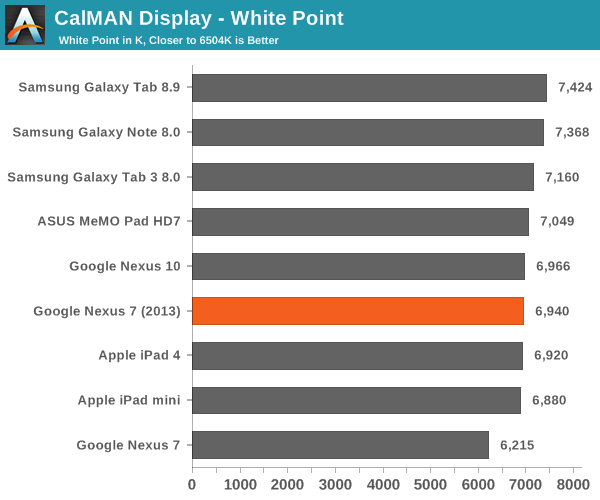
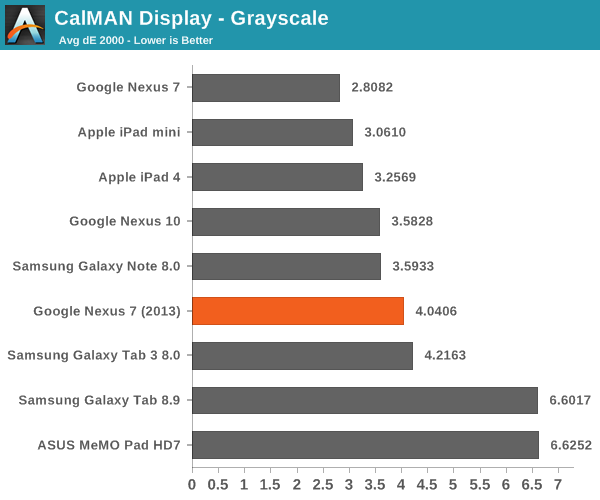
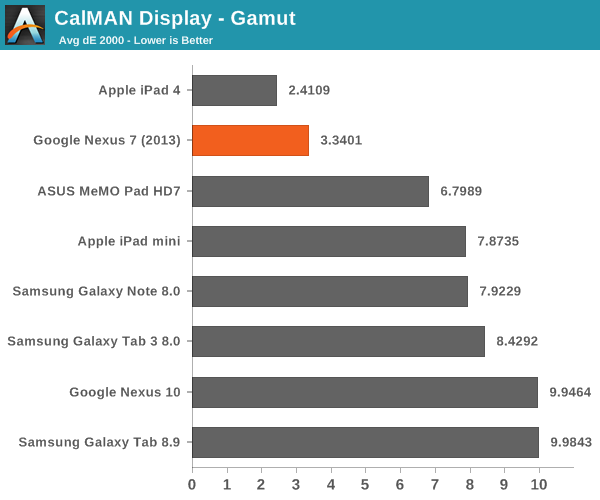
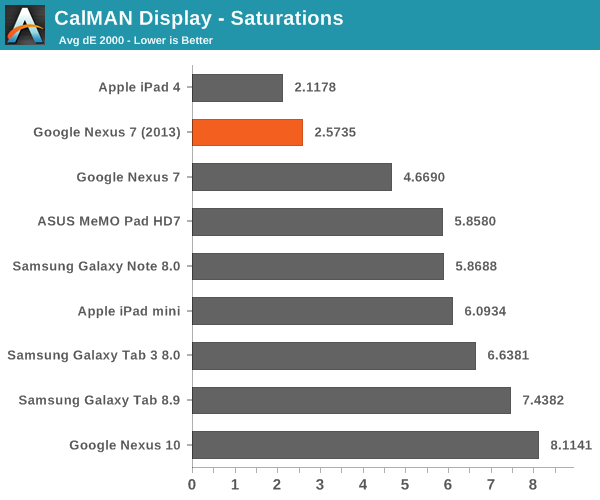
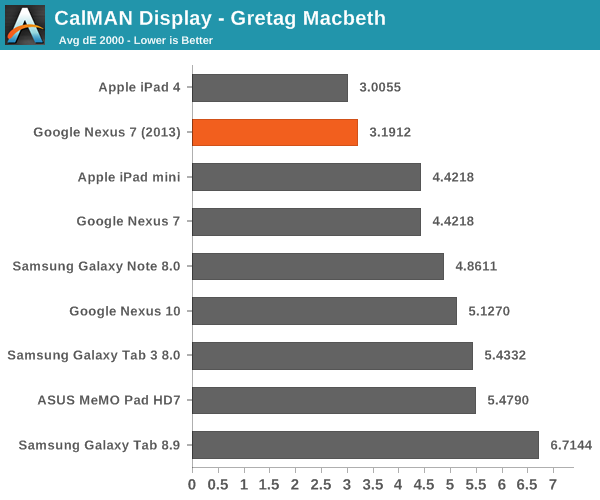
The new panel is also incredibly bright. I typically view 500 nits as the threshold for outdoor usability, and the new Nexus 7 definitely exceeds that threshold. The tablet will drink away all of your battery life if you leave it at this brightness setting indefinitely, but if you need to actually use your tablet outdoors for a while the Nexus 7 works.

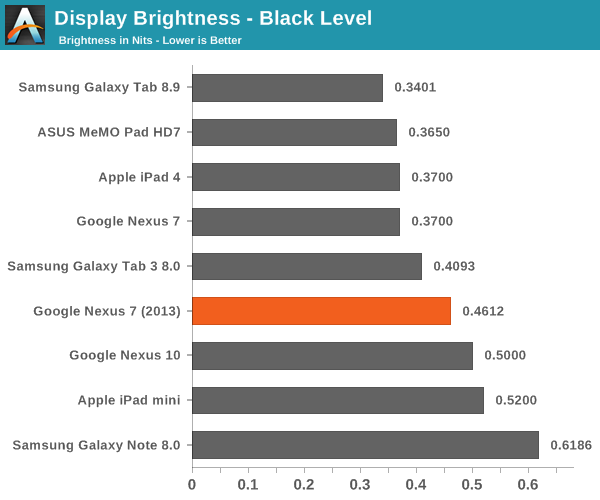
Black levels are a bit higher than on the original Nexus 7, but the resulting peak contrast ratio is still excellent:
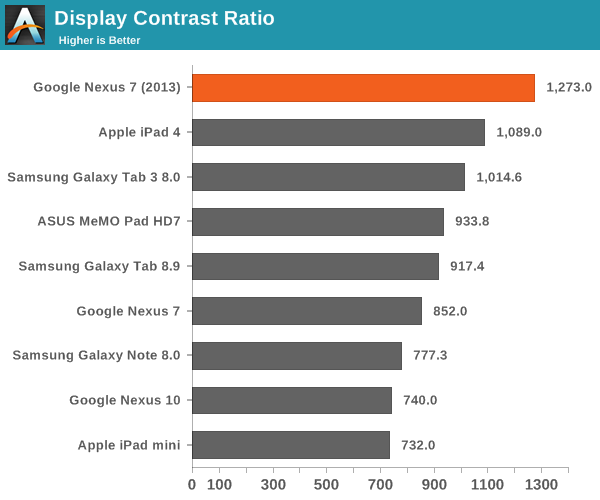
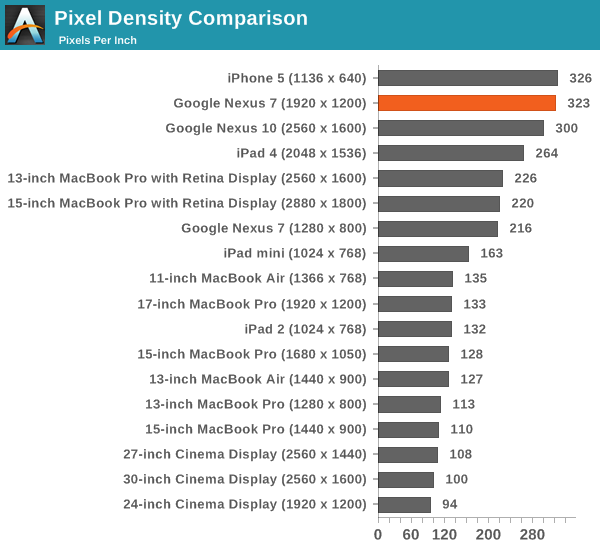
Pixel density shoots through the roof with the new Nexus 7 display as well. Brian was quick to point out that a major advantage of the Android platform is in its flexible resolution handling. The 1920 x 1200 panel presents itself as a 960 x 600 panel to web pages in Chrome, while other apps can use every last pixel for unique content (e.g. games).
The beauty of not having to double the original Nexus 7's resolution but instead settling on an in-between option like 1920 x 1200 is that Google could get away with a performance mainstream SoC instead of something ridiculously high-end.
The display looks great when viewing everything from photos and movies to web pages and eBooks. My only complaint about the Nexus 7's display is its size. A 7-inch tablet is almost pocketable (in fact I did carry it around in my pocket for a day), but the screen can feel a little cramped.


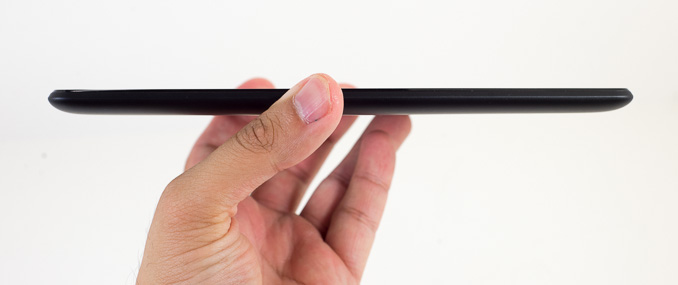
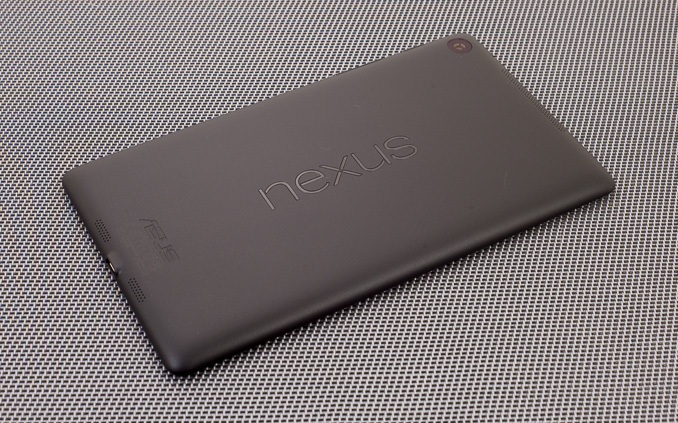
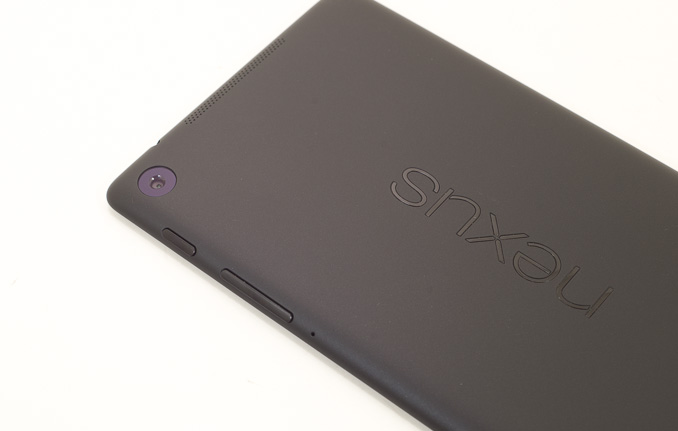


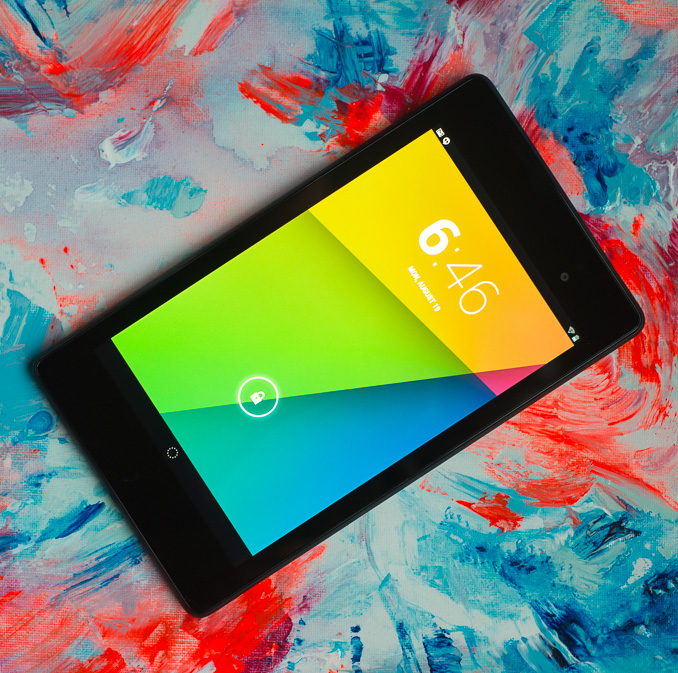
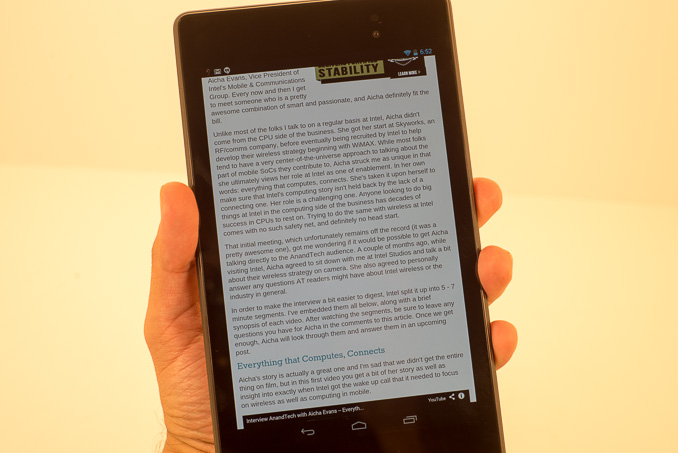
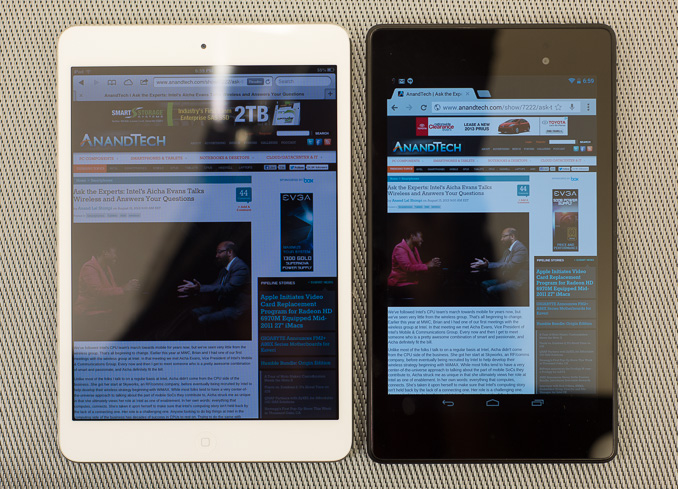








202 Comments
View All Comments
ESC2000 - Thursday, August 29, 2013 - link
I agree with everyone who is perplexed that you object to paying less. Also remember though that Asus manufactured these tablets and they certainly aren't working for no profit. I think I read somewhere that Asus gets $4 per nexus 7.... certainly not the $150 or whatever that Apple makes on each mini (not to mention the extra $100 for each storage upgrade) but it adds up.Of course they may be selling at or below cost and Google might just be paying Asus. Hopefully we won't all end up working as slaves to Google... -written from my happily-obtained at cost nexus 7 2013
jl0329 - Wednesday, October 9, 2013 - link
You are wrong on so many levels, I don't know where to begin...Arbie - Thursday, August 22, 2013 - link
Well, I may have to get used to it, but I don't want to. Hence the comment. And in what way does SD "suck"? Micro and standard SD work perfectly for me in about eight different devices, and have done so for years.
Wait - I just figured it out: you're putting the chip in backwards. Google for some help with that.
Arbie - Thursday, August 22, 2013 - link
You simply prove my point. Without a micro/SD slot you have to spend hours grinding your videos down just to fit the hardware AND keep a computer available (!!) to reload your tablet memory. That whole scenario is so infinitely more difficult than just snapping tiny chips in and out that it doesn't even parse. People - we should be bitching more about this, or we *will* have to get used to no SD.Arbie - Thursday, August 22, 2013 - link
Yeah, at about 1000x the size, weight, hassle, and fragility of a microSD card, it's not as elegant... That's exactly why we need micro/SD.BMNify - Thursday, August 22, 2013 - link
Anand will you please point out that Nexus devices are sold at-cost to the consumers, Google subsidised prices can't be compared with the other hardware manufacturers.sherlockwing - Thursday, August 22, 2013 - link
I guess Amazon doesn't count as "other hardware manufactuers" with their Kindle Fire Tablets?BMNify - Thursday, August 22, 2013 - link
Nope, Amazon doesn't count, now they can easily exit the market too if they want as their objective of cheap tablets as their delivery vehicle is achieved as mentioned by Brian Klug in one of the podcasts but they will still stay in the market so that they are not totally dependent on other ecosystems.sherlockwing - Friday, August 23, 2013 - link
If "cheap tablets as content delivery vehicle" is the Amazon model, it is the same as the Google model (use N7 to expand Android App user base, especially those that use Google Apps). If you declare "Amazon doesn't count" then Google doesn't count either by the same logic of yours.akdj - Sunday, August 25, 2013 - link
'especially those that use Google Apps'. That's the nail on the head. Google doesn't care about the 'Play Store"...in the sense of it being a money maker. Google is first and foremost an advertising company. The biggest in the world. The 'google apps' are exactly and precisely why they're selling these and their phones @ cost. It's also the same reason they release excellent iOS apps. For Google, your info...that's their gold mine. Nothing more, nothing less. Apple on the other hand IS a hardware manufacturer. Just so happens the App Store is extremely lucrative and would qualify as a Fortune 500 company on its own. As is iTunes. They make real, hard cash for those endeavors.Two completely different philosophies and goals
Amazon on the other hand...again, offering the Kindle @ cost allows for a quick and easy portal to purchase everything from diapers and peanut butter to the latest Stephen King novel or Tom Petty's new album. They're selling you a shopping bag that'll fit anything from the store (and your credit card) you'd like to buy
Just so happens...other vendors are now involving themselves attempting to compete with these two (3) different ways of thinking and running Android with their OEMs skin. Competition is good. These tablets in their current, usable and consumer available format have only been around for three years! As a 42 year old enjoyer of all things tech related, I find it a very exciting time to be involved with and 'into' technology. It's amazing what's happened in only 36 months....we've got more software available at our fingertips (with smartphones included) than any other time in history. 800,000+ apps on each platform....obviously with some parity. But just five years ago a decent game on a handheld gaming device was $59 on release! When I was a kid...my Mattell handheld football game cost my folks a good $30 bill for Christmas!
It's funny how 'religious' these OS debates have become. I own both Android and iOS devices....Work in Windows and Mac PCs...and I'm excited for everyone's press conference. How most of us that frequent Anand's site don't feel the same is beyond me. I'm just thankful the staff here is as passionate AND as objective as any human could ever be when it comes to technology review.
And to think....you don't pay a dime, most of you...to come enjoy their articles and in depth reviews anytime you choose???
Why such animosity? And why complain or argue? Debate is good...but so many of these tangent conversations seem to just 'not get it'. Seems ignorance has run rampant since the invention of the 'smart phone'....turned all of us into 'dumb people'
Just my cent and a half (I bought the new Nex7 myself...don't have a full two cents, I'm saving for the new 'mini' this fall;))